towing FIAT LINEA 2008 1.G Owners Manual
[x] Cancel search | Manufacturer: FIAT, Model Year: 2008, Model line: LINEA, Model: FIAT LINEA 2008 1.GPages: 234, PDF Size: 3.41 MB
Page 125 of 234
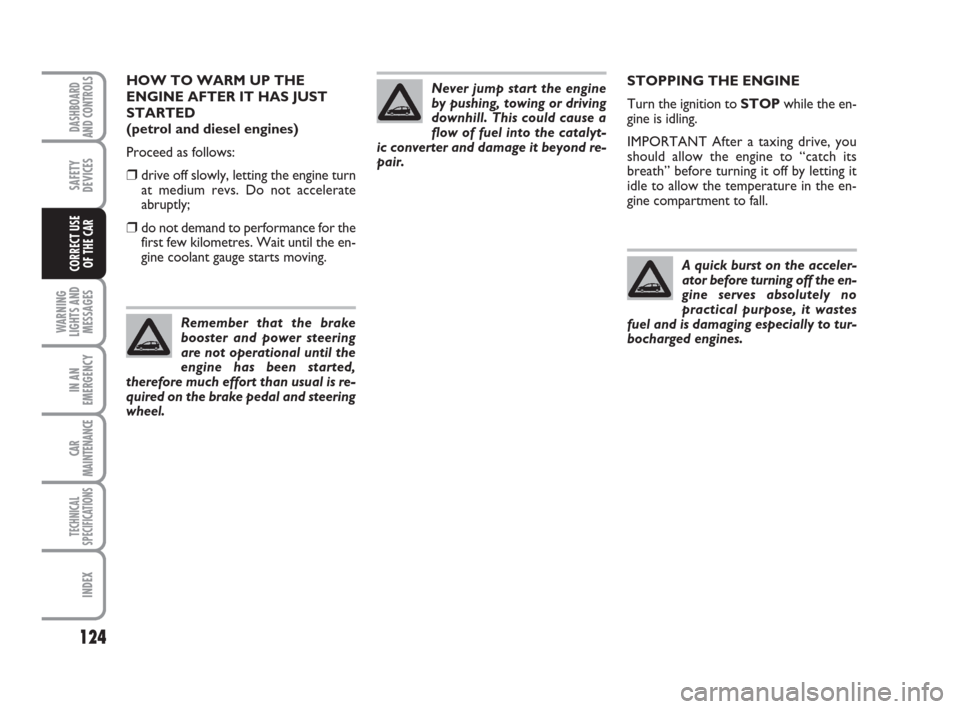
124
WARNING
LIGHTS AND
MESSAGES
IN AN
EMERGENCY
CAR
MAINTENANCE
TECHNICAL
SPECIFICATIONS
INDEX
DASHBOARD
AND CONTROLS
SAFETY
DEVICES
CORRECT USE
OF THE CAR
STOPPING THE ENGINE
Turn the ignition to STOPwhile the en-
gine is idling.
IMPORTANT After a taxing drive, you
should allow the engine to “catch its
breath” before turning it off by letting it
idle to allow the temperature in the en-
gine compartment to fall.
A quick burst on the acceler-
ator before turning off the en-
gine serves absolutely no
practical purpose, it wastes
fuel and is damaging especially to tur-
bocharged engines.HOW TO WARM UP THE
ENGINE AFTER IT HAS JUST
STARTED
(petrol and diesel engines)
Proceed as follows:
❒drive off slowly, letting the engine turn
at medium revs. Do not accelerate
abruptly;
❒do not demand to performance for the
first few kilometres. Wait until the en-
gine coolant gauge starts moving.
Remember that the brake
booster and power steering
are not operational until the
engine has been started,
therefore much effort than usual is re-
quired on the brake pedal and steering
wheel.
Never jump start the engine
by pushing, towing or driving
downhill. This could cause a
flow of fuel into the catalyt-
ic converter and damage it beyond re-
pair.
121-132 LINEA 1ed GB 3-09-2008 17:30 Pagina 124
Page 129 of 234
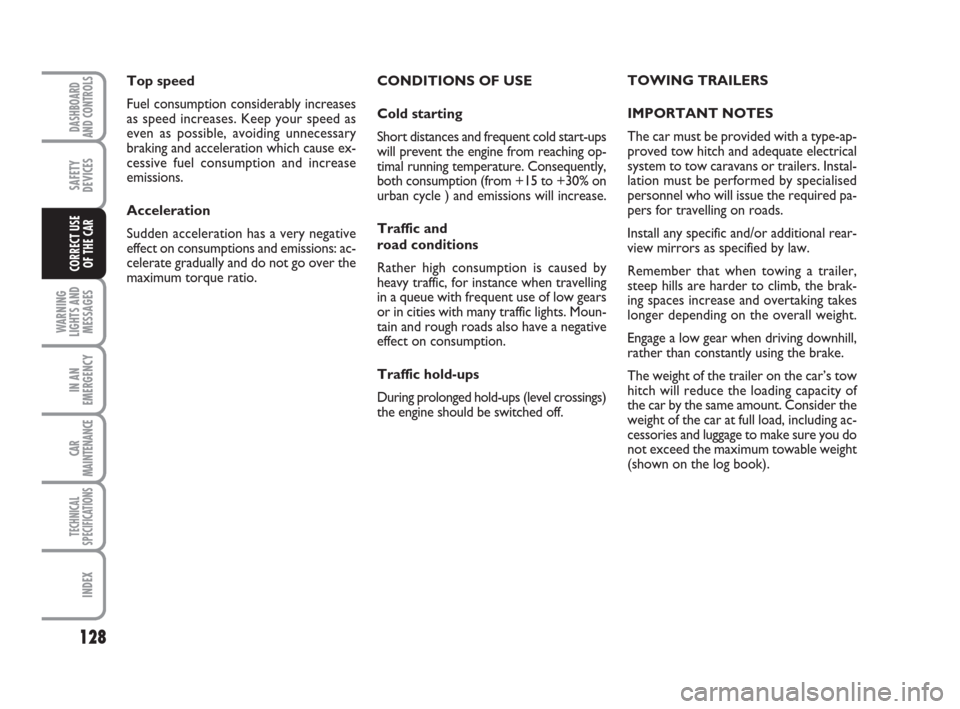
128
WARNING
LIGHTS AND
MESSAGES
IN AN
EMERGENCY
CAR
MAINTENANCE
TECHNICAL
SPECIFICATIONS
INDEX
DASHBOARD
AND CONTROLS
SAFETY
DEVICES
CORRECT USE
OF THE CAR
CONDITIONS OF USE
Cold starting
Short distances and frequent cold start-ups
will prevent the engine from reaching op-
timal running temperature. Consequently,
both consumption (from +15 to +30% on
urban cycle ) and emissions will increase.
Traffic and
road conditions
Rather high consumption is caused by
heavy traffic, for instance when travelling
in a queue with frequent use of low gears
or in cities with many traffic lights. Moun-
tain and rough roads also have a negative
effect on consumption.
Traffic hold-ups
During prolonged hold-ups (level crossings)
the engine should be switched off.TOWING TRAILERS
IMPORTANT NOTES
The car must be provided with a type-ap-
proved tow hitch and adequate electrical
system to tow caravans or trailers. Instal-
lation must be performed by specialised
personnel who will issue the required pa-
pers for travelling on roads.
Install any specific and/or additional rear-
view mirrors as specified by law.
Remember that when towing a trailer,
steep hills are harder to climb, the brak-
ing spaces increase and overtaking takes
longer depending on the overall weight.
Engage a low gear when driving downhill,
rather than constantly using the brake.
The weight of the trailer on the car’s tow
hitch will reduce the loading capacity of
the car by the same amount. Consider the
weight of the car at full load, including ac-
cessories and luggage to make sure you do
not exceed the maximum towable weight
(shown on the log book). Top speed
Fuel consumption considerably increases
as speed increases. Keep your speed as
even as possible, avoiding unnecessary
braking and acceleration which cause ex-
cessive fuel consumption and increase
emissions.
Acceleration
Sudden acceleration has a very negative
effect on consumptions and emissions: ac-
celerate gradually and do not go over the
maximum torque ratio.
121-132 LINEA 1ed GB 3-09-2008 17:30 Pagina 128
Page 130 of 234
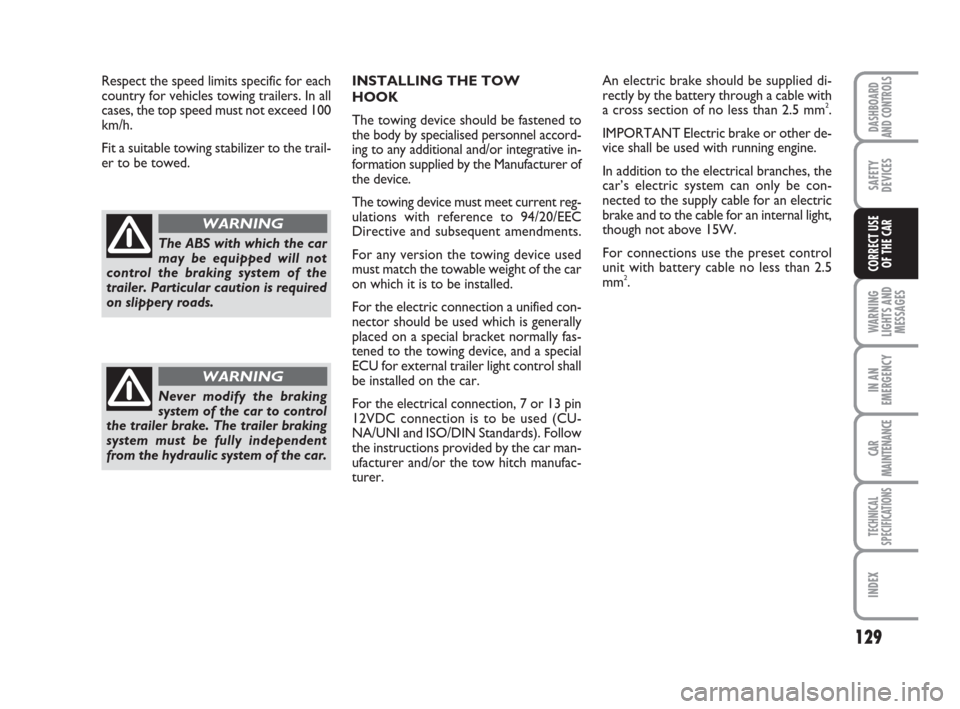
129
WARNING
LIGHTS AND
MESSAGES
IN AN
EMERGENCY
CAR
MAINTENANCE
TECHNICAL
SPECIFICATIONS
INDEX
DASHBOARD
AND CONTROLS
SAFETY
DEVICES
CORRECT USE
OF THE CAR
INSTALLING THE TOW
HOOK
The towing device should be fastened to
the body by specialised personnel accord-
ing to any additional and/or integrative in-
formation supplied by the Manufacturer of
the device.
The towing device must meet current reg-
ulations with reference to 94/20/EEC
Directive and subsequent amendments.
For any version the towing device used
must match the towable weight of the car
on which it is to be installed.
For the electric connection a unified con-
nector should be used which is generally
placed on a special bracket normally fas-
tened to the towing device, and a special
ECU for external trailer light control shall
be installed on the car.
For the electrical connection, 7 or 13 pin
12VDC connection is to be used (CU-
NA/UNI and ISO/DIN Standards). Follow
the instructions provided by the car man-
ufacturer and/or the tow hitch manufac-
turer.An electric brake should be supplied di-
rectly by the battery through a cable with
a cross section of no less than 2.5 mm
2.
IMPORTANT Electric brake or other de-
vice shall be used with running engine.
In addition to the electrical branches, the
car’s electric system can only be con-
nected to the supply cable for an electric
brake and to the cable for an internal light,
though not above 15W.
For connections use the preset control
unit with battery cable no less than 2.5
mm
2. Respect the speed limits specific for each
country for vehicles towing trailers. In all
cases, the top speed must not exceed 100
km/h.
Fit a suitable towing stabilizer to the trail-
er to be towed.
The ABS with which the car
may be equipped will not
control the braking system of the
trailer. Particular caution is required
on slippery roads.
WARNING
Never modify the braking
system of the car to control
the trailer brake. The trailer braking
system must be fully independent
from the hydraulic system of the car.
WARNING
121-132 LINEA 1ed GB 3-09-2008 17:30 Pagina 129
Page 137 of 234
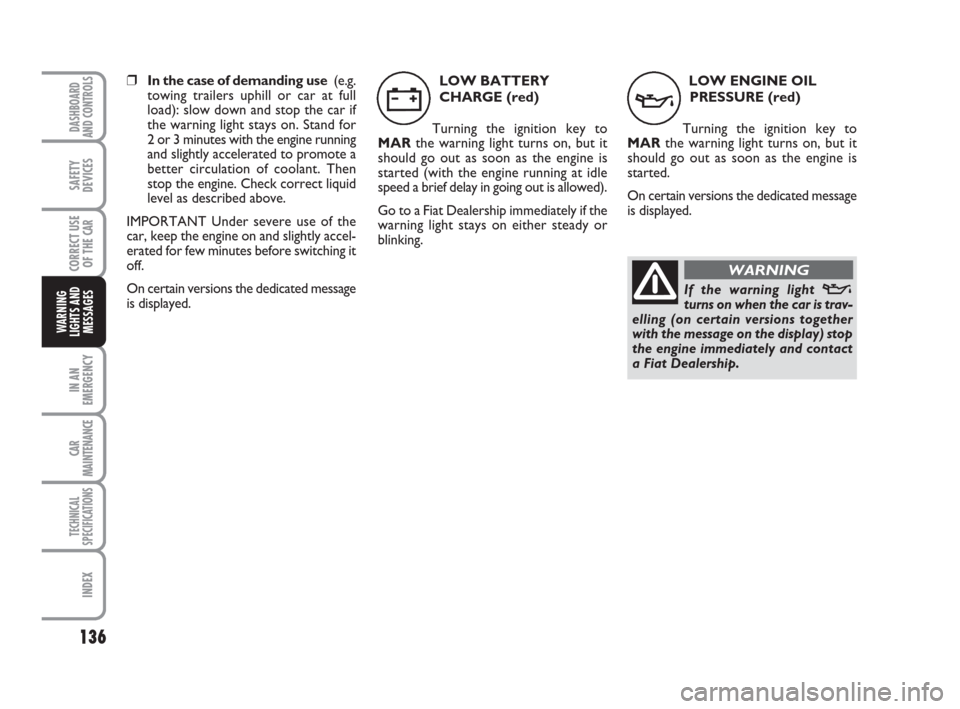
136
IN AN
EMERGENCY
CAR
MAINTENANCE
TECHNICAL
SPECIFICATIONS
INDEX
DASHBOARD
AND CONTROLS
SAFETY
DEVICES
CORRECT USE
OF THE
CAR
WARNING
LIGHTS AND
MESSAGES
LOW ENGINE OIL
PRESSURE (red)
Turning the ignition key to
MARthe warning light turns on, but it
should go out as soon as the engine is
started.
On certain versions the dedicated message
is displayed.
v
If the warning light vturns on when the car is trav-
elling (on certain versions together
with the message on the display) stop
the engine immediately and contact
a Fiat Dealership.
WARNING
❒In the case of demanding use (e.g.
towing trailers uphill or car at full
load): slow down and stop the car if
the warning light stays on. Stand for
2 or 3 minutes with the engine running
and slightly accelerated to promote a
better circulation of coolant. Then
stop the engine. Check correct liquid
level as described above.
IMPORTANT Under severe use of the
car, keep the engine on and slightly accel-
erated for few minutes before switching it
off.
On certain versions the dedicated message
is displayed.LOW BATTERY
CHARGE (red)
Turning the ignition key to
MARthe warning light turns on, but it
should go out as soon as the engine is
started (with the engine running at idle
speed a brief delay in going out is allowed).
Go to a Fiat Dealership immediately if the
warning light stays on either steady or
blinking.
w
133-144 LINEA 1ed GB 3-09-2008 17:31 Pagina 136
Page 146 of 234
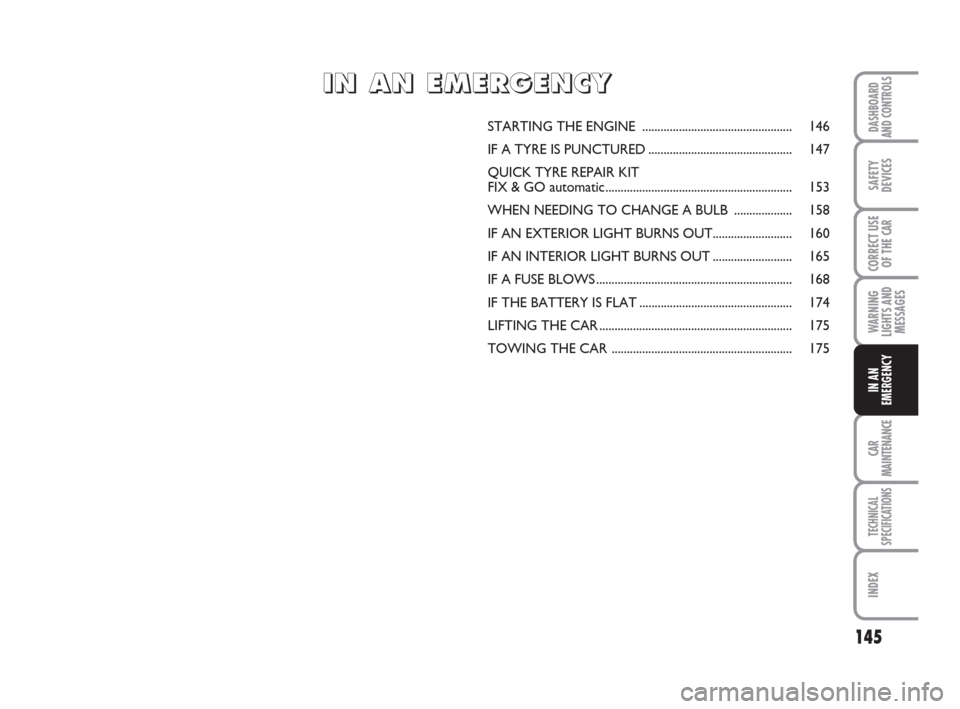
145
WARNING
LIGHTS AND
MESSAGES
CAR
MAINTENANCE
TECHNICAL
SPECIFICATIONS
INDEX
DASHBOARD
AND CONTROLS
SAFETY
DEVICES
CORRECT USE
OF THE
CAR
IN AN
EMERGENCY
STARTING THE ENGINE ................................................. 146
IF A TYRE IS PUNCTURED............................................... 147
QUICK TYRE REPAIR KIT
FIX & GO automatic............................................................. 153
WHEN NEEDING TO CHANGE A BULB ................... 158
IF AN EXTERIOR LIGHT BURNS OUT.......................... 160
IF AN INTERIOR LIGHT BURNS OUT.......................... 165
IF A FUSE BLOWS................................................................ 168
IF THE BATTERY IS FLAT .................................................. 174
LIFTING THE CAR............................................................... 175
TOWING THE CAR ........................................................... 175
II I
N N
A A
N N
E E
M M
E E
R R
G G
E E
N N
C C
Y Y
145-176 LINEA 1ed GB 5-09-2008 9:22 Pagina 145
Page 148 of 234
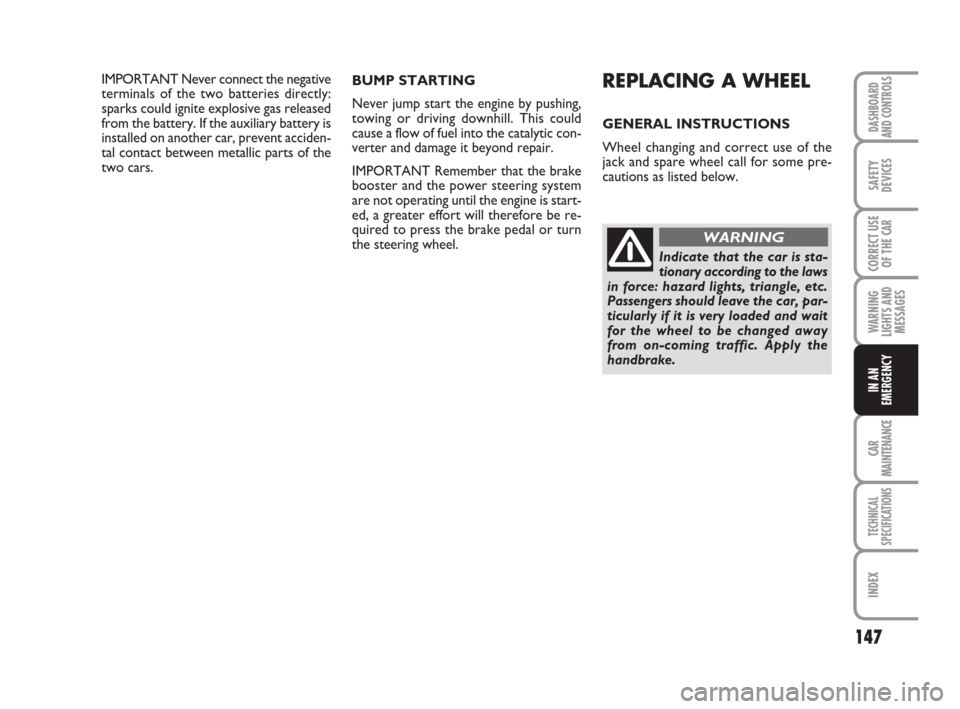
147
WARNING
LIGHTS AND
MESSAGES
CAR
MAINTENANCE
TECHNICAL
SPECIFICATIONS
INDEX
DASHBOARD
AND CONTROLS
SAFETY
DEVICES
CORRECT USE
OF THE
CAR
IN AN
EMERGENCY
IMPORTANT Never connect the negative
terminals of the two batteries directly:
sparks could ignite explosive gas released
from the battery. If the auxiliary battery is
installed on another car, prevent acciden-
tal contact between metallic parts of the
two cars.BUMP STARTING
Never jump start the engine by pushing,
towing or driving downhill. This could
cause a flow of fuel into the catalytic con-
verter and damage it beyond repair.
IMPORTANT Remember that the brake
booster and the power steering system
are not operating until the engine is start-
ed, a greater effort will therefore be re-
quired to press the brake pedal or turn
the steering wheel.REPLACING A WHEEL
GENERAL INSTRUCTIONS
Wheel changing and correct use of the
jack and spare wheel call for some pre-
cautions as listed below.
Indicate that the car is sta-
tionary according to the laws
in force: hazard lights, triangle, etc.
Passengers should leave the car, par-
ticularly if it is very loaded and wait
for the wheel to be changed away
from on-coming traffic. Apply the
handbrake.
WARNING
145-176 LINEA 1ed GB 5-09-2008 9:22 Pagina 147
Page 176 of 234
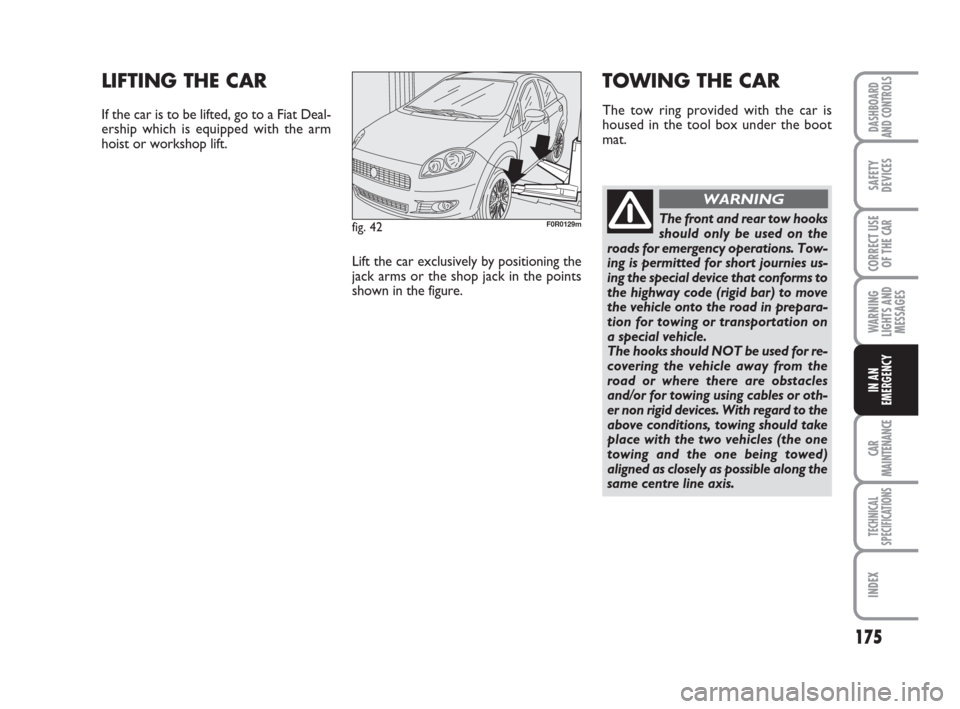
175
WARNING
LIGHTS AND
MESSAGES
CAR
MAINTENANCE
TECHNICAL
SPECIFICATIONS
INDEX
DASHBOARD
AND CONTROLS
SAFETY
DEVICES
CORRECT USE
OF THE
CAR
IN AN
EMERGENCY
fig. 42F0R0129m
LIFTING THE CAR
If the car is to be lifted, go to a Fiat Deal-
ership which is equipped with the arm
hoist or workshop lift.
Lift the car exclusively by positioning the
jack arms or the shop jack in the points
shown in the figure.
TOWING THE CAR
The tow ring provided with the car is
housed in the tool box under the boot
mat.
The front and rear tow hooks
should only be used on the
roads for emergency operations. Tow-
ing is permitted for short journies us-
ing the special device that conforms to
the highway code (rigid bar) to move
the vehicle onto the road in prepara-
tion for towing or transportation on
a special vehicle.
The hooks should NOT be used for re-
covering the vehicle away from the
road or where there are obstacles
and/or for towing using cables or oth-
er non rigid devices. With regard to the
above conditions, towing should take
place with the two vehicles (the one
towing and the one being towed)
aligned as closely as possible along the
same centre line axis.
WARNING
145-176 LINEA 1ed GB 5-09-2008 9:22 Pagina 175
Page 177 of 234
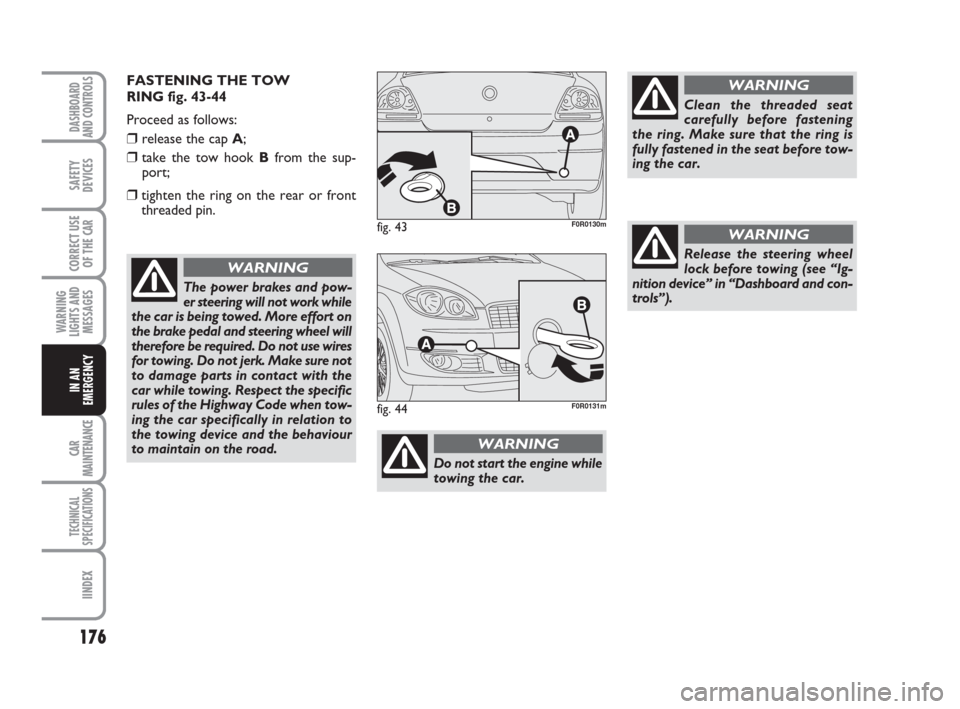
176
WARNING
LIGHTS AND
MESSAGES
CAR
MAINTENANCE
TECHNICAL
SPECIFICATIONS
IINDEX
DASHBOARD
AND CONTROLS
SAFETY
DEVICES
CORRECT USE
OF THE
CAR
IN AN
EMERGENCY
FASTENING THE TOW
RING fig. 43-44
Proceed as follows:
❒release the cap A;
❒take the tow hook Bfrom the sup-
port;
❒tighten the ring on the rear or front
threaded pin.
The power brakes and pow-
er steering will not work while
the car is being towed. More effort on
the brake pedal and steering wheel will
therefore be required. Do not use wires
for towing. Do not jerk. Make sure not
to damage parts in contact with the
car while towing. Respect the specific
rules of the Highway Code when tow-
ing the car specifically in relation to
the towing device and the behaviour
to maintain on the road.
WARNING
fig. 43F0R0130m
fig. 44F0R0131m
Do not start the engine while
towing the car.
WARNING
Clean the threaded seat
carefully before fastening
the ring. Make sure that the ring is
fully fastened in the seat before tow-
ing the car.
WARNING
Release the steering wheel
lock before towing (see “Ig-
nition device” in “Dashboard and con-
trols”).
WARNING
145-176 LINEA 1ed GB 5-09-2008 9:22 Pagina 176
Page 179 of 234
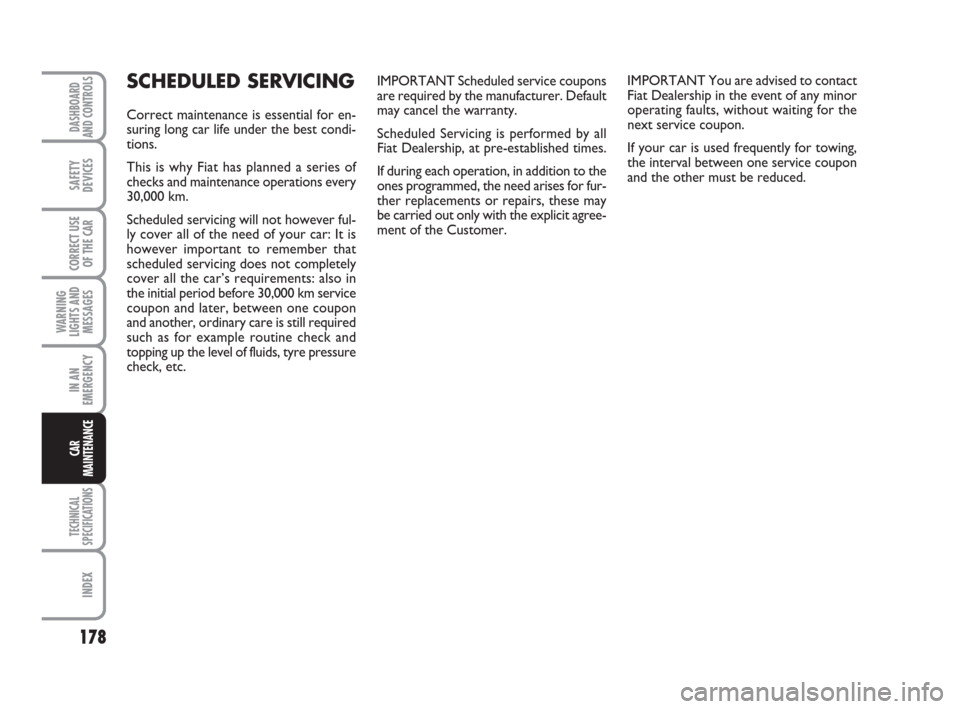
178
WARNING
LIGHTS AND
MESSAGES
TECHNICAL
SPECIFICATIONS
INDEX
DASHBOARD
AND CONTROLS
SAFETY
DEVICES
CORRECT USE
OF THE CAR
IN AN
EMERGENCY
CAR
MAINTENANCE
IMPORTANT Scheduled service coupons
are required by the manufacturer. Default
may cancel the warranty.
Scheduled Servicing is performed by all
Fiat Dealership, at pre-established times.
If during each operation, in addition to the
ones programmed, the need arises for fur-
ther replacements or repairs, these may
be carried out only with the explicit agree-
ment of the Customer.IMPORTANT You are advised to contact
Fiat Dealership in the event of any minor
operating faults, without waiting for the
next service coupon.
If your car is used frequently for towing,
the interval between one service coupon
and the other must be reduced.SCHEDULED SERVICING
Correct maintenance is essential for en-
suring long car life under the best condi-
tions.
This is why Fiat has planned a series of
checks and maintenance operations every
30,000 km.
Scheduled servicing will not however ful-
ly cover all of the need of your car: It is
however important to remember that
scheduled servicing does not completely
cover all the car’s requirements: also in
the initial period before 30,000 km service
coupon and later, between one coupon
and another, ordinary care is still required
such as for example routine check and
topping up the level of fluids, tyre pressure
check, etc.
177-200 LINEA 1ed GB 3-09-2008 17:31 Pagina 178
Page 184 of 234
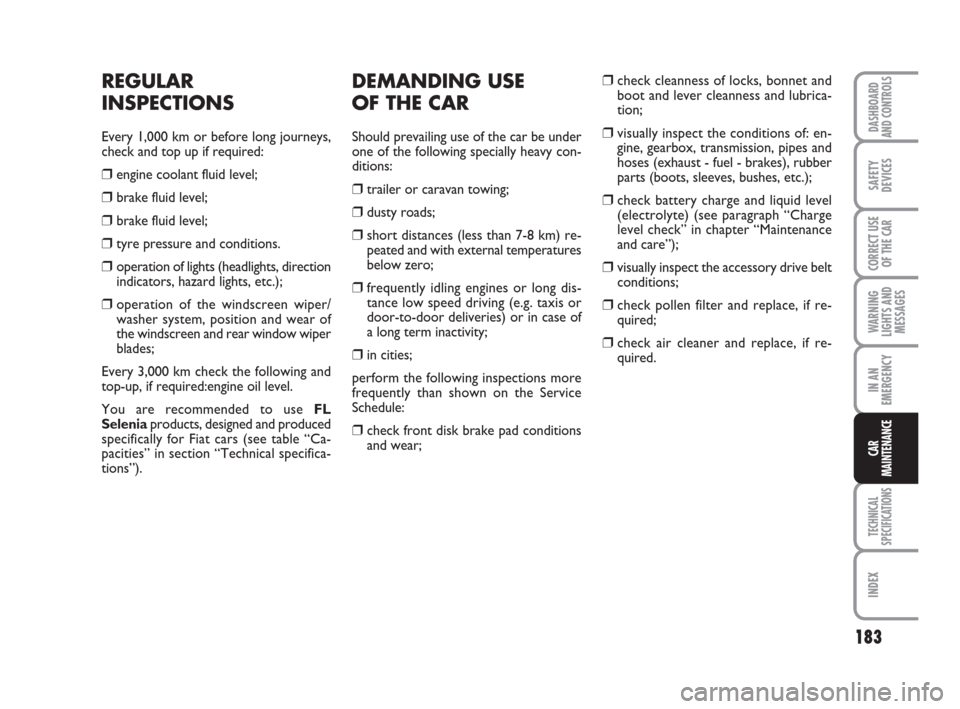
183
WARNING
LIGHTS AND
MESSAGES
TECHNICAL
SPECIFICATIONS
INDEX
DASHBOARD
AND CONTROLS
SAFETY
DEVICES
CORRECT USE
OF THE CAR
IN AN
EMERGENCY
CAR
MAINTENANCE
DEMANDING USE
OF THE CAR
Should prevailing use of the car be under
one of the following specially heavy con-
ditions:
❒trailer or caravan towing;
❒dusty roads;
❒short distances (less than 7-8 km) re-
peated and with external temperatures
below zero;
❒frequently idling engines or long dis-
tance low speed driving (e.g. taxis or
door-to-door deliveries) or in case of
a long term inactivity;
❒in cities;
perform the following inspections more
frequently than shown on the Service
Schedule:
❒check front disk brake pad conditions
and wear;
❒check cleanness of locks, bonnet and
boot and lever cleanness and lubrica-
tion;
❒visually inspect the conditions of: en-
gine, gearbox, transmission, pipes and
hoses (exhaust - fuel - brakes), rubber
parts (boots, sleeves, bushes, etc.);
❒check battery charge and liquid level
(electrolyte) (see paragraph “Charge
level check” in chapter “Maintenance
and care”);
❒visually inspect the accessory drive belt
conditions;
❒check pollen filter and replace, if re-
quired;
❒check air cleaner and replace, if re-
quired.
REGULAR
INSPECTIONS
Every 1,000 km or before long journeys,
check and top up if required:
❒engine coolant fluid level;
❒brake fluid level;
❒brake fluid level;
❒tyre pressure and conditions.
❒operation of lights (headlights, direction
indicators, hazard lights, etc.);
❒operation of the windscreen wiper/
washer system, position and wear of
the windscreen and rear window wiper
blades;
Every 3,000 km check the following and
top-up, if required:engine oil level.
You are recommended to use FL
Seleniaproducts, designed and produced
specifically for Fiat cars (see table “Ca-
pacities” in section “Technical specifica-
tions”).
177-200 LINEA 1ed GB 3-09-2008 17:31 Pagina 183